In Vivo Chemical Screening in Zebrafish Embryos Identified FDA-Approved Drugs That Induce Differentiation of Acute Myeloid Leukemia Cells
- PMID: 39063039
- PMCID: PMC11277044
- DOI: 10.3390/ijms25147798
In Vivo Chemical Screening in Zebrafish Embryos Identified FDA-Approved Drugs That Induce Differentiation of Acute Myeloid Leukemia Cells
Abstract
Acute myeloid leukemia (AML) is characterized by the abnormal proliferation and differentiation arrest of myeloid progenitor cells. The clinical treatment of AML remains challenging. Promoting AML cell differentiation is a valid strategy, but effective differentiation drugs are lacking for most types of AML. In this study, we generated Tg(drl:hoxa9) zebrafish, in which hoxa9 overexpression was driven in hematopoietic cells and myeloid differentiation arrest was exhibited. Using Tg(drl:hoxa9) embryos, we performed chemical screening and identified four FDA-approved drugs, ethacrynic acid, khellin, oxcarbazepine, and alendronate, that efficiently restored myeloid differentiation. The four drugs also induced AML cell differentiation, with ethacrynic acid being the most effective. By an RNA-seq analysis, we found that during differentiation, ethacrynic acid activated the IL-17 and MAPK signaling pathways, which are known to promote granulopoiesis. Furthermore, we found that ethacrynic acid enhanced all-trans retinoic acid (ATRA)-induced differentiation, and both types of signaling converged on the IL-17/MAPK pathways. Inhibiting the IL-17/MAPK pathways impaired ethacrynic acid and ATRA-induced differentiation. In addition, we showed that ethacrynic acid is less toxic to embryogenesis and less disruptive to normal hematopoiesis than ATRA. Thus, the combination of ethacrynic acid and ATRA may have broader clinical applications. In conclusion, through zebrafish-aided screening, our study identified four drugs that can be repurposed to induce AML differentiation, thus providing new agents for AML therapy.
Keywords: IL-17/MAPK; acute myeloid leukemia; all-trans retinoic acid; ethacrynic acid; myeloid differentiation; zebrafish.
Conflict of interest statement
The authors declare no conflict of interest.
Figures






References
MeSH terms
Substances
Grants and funding
LinkOut - more resources
Full Text Sources
Medical
Molecular Biology Databases
Miscellaneous

